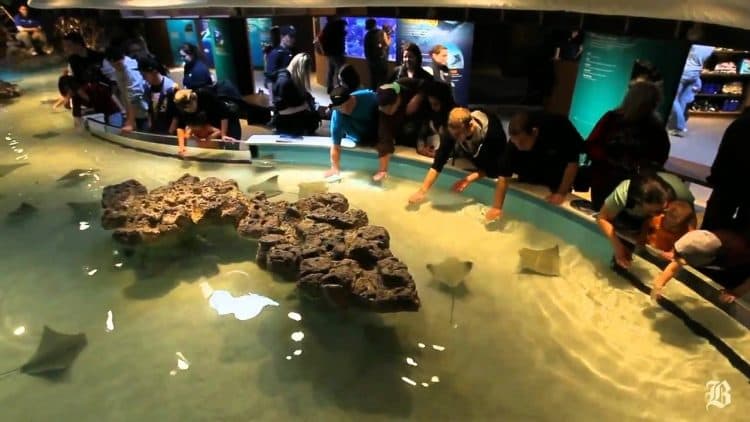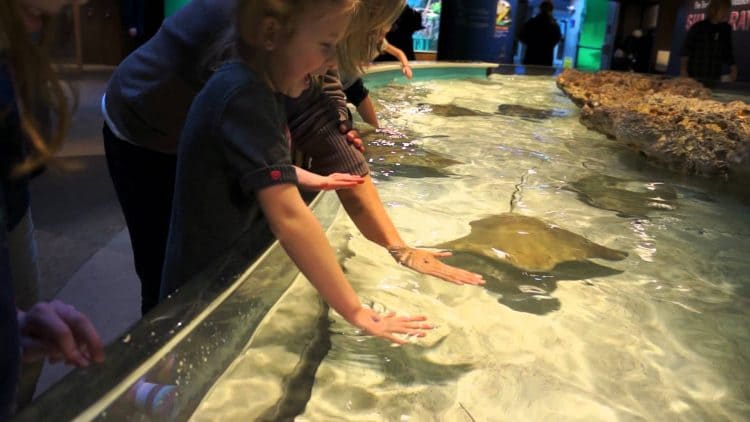Touch tanks are shallow tanks of water, usually raised so public does not have to bend over, that contain animals and plants from an aquatic environment (usually local) that the public can touch and/or pick up to examine. Touch tanks can be found at various aquariums, nature centers, zoos, pet stores, pet supply places, and even the Tampa Bay Devil Rays baseball field (their touch tank containing rays is 35 feet long, and holds 10,000 gallons).

Design
Stationary touch tank: Should be a self-contained, closed loop system, not connected to other tanks. Should have undergravel and diatom filters, plus UV light and/or ozone sterilization (all tank support equipment should be placed under the touch tank, or otherwise out of reach/sight of the public). Tank should not be wider than twice the average length of human arm for ease of picking up animals in tank (assuming public has access to both sides of tank). Tank interior should have rounded corners so animals do not get stuck in one place and dig so much the filter screen gets damaged. Drain pipe must be larger than inflow pipe so there is not back-up of water in the touch tank proper. Should have shallow water depth so as little of human arm goes into water as possible (less contamination of tank water from human skin care products and less surface area of human body put into water for possible entrance of bacteria). Should be shaded from sun (or excessive light) so there is no algae problem, or water overheating problem. Should have light-colored (pastel colors usually favored) tank interior so lot of heat not absorbed, and organisms easier seen. Should have shallow substrate in tank so burying animals cannot hide too deep and not be available for inspection and so public does not stir up tank debris by digging. Should have smooth tank surfaces for ease of cleaning. Should have ground fault interrupters in electrical wiring support system. Water reservoir should have holding trays for keeping extra display animals in reserve, or for isolating stressed animals away from the public handling. Aeration should be done in the hidden reservoir, so aerosols are not formed near the public. Aquascaping, substrate, animals displayed, and tank surfaces should not have any sharp parts that could cause human injury (site for bacterial entry).
Portable touch tank: For taking to school classrooms, festivals, etc. Should be lightweight for ease of handling/transport. Could consist of various plastic containers in which animals are both transported and displayed. Should contain shallow water, so animals in tank(s) agitate water by their movements and thus add oxygen to water. If possible, run tank water through UV light sterilizer while portable tank is being used by the public. If not possible, filter the transport/display water with a diatom filter and sterilize it with UV light prior to transport and setting up portable touch tank.
Support equipment for stationary touch tanks
- To protect animals from human toxins: Use an in-line (after water exits touch tank) activated charcoal filter on the touch tank water supply system to absorb any toxins from hand cream, perfume, sun screen, antibiotic salve, soap, etc. that humans may put on their hands and/or arms. The charcoal in the filter should be periodically replaced with new charcoal, and the used charcoal discarded.
- To protect humans from water-borne bacteria: UV light sterilizer(s) (a minimum of one, in line after water exits reservoir and prior to going to touch tank; another is recommended in line after water exits touch tank), and other support equipment as ozone generator, diatom filter, protein skimmer, pumps, etc. should all be installed on water reservoir away from public view. Dead and dying animals, and excessive organics (including uneaten food), should be removed as soon as possible to prevent build-up of bacteria.
- To protect humans from other humans that utilize touch tank: Must try to kill human pathogenic bacteria that enter system via hands/arms, hair, wounds, spittle, etc. Use UV light sterilizer on system (hidden from view), at least one in line just prior to water going to touch tank, and other support equipment as listed above, to try to control pathogens introduced by humans.
Maintenance
- Replace UV light bulb, as needed (Most important thing for operation and liability problems with a touch tank is to make sure the sterilization units (UV light and/or ozone) are working correctly to kill water-borne bacteria so humans have a reduced chance of getting infected.).
- Clean, recharge all filters as needed (Diatom filter can assist in removing some bacteria from tank water.).
- Verify all pumps are working.
- Add fresh water to replace water lost to evaporation.
- Clean undergravel filters as needed, to prevent compaction and to remove accumulated detritus.
- Cover filter screen with substrate, if exposed.
- Clean exit drain screen of debris, as needed, to prevent water back-up in touch tank.
- Replace injured or stressed display animals; treat injured animals.
- Clean debris (from animals or public) out of tank, as seen.
- Check for leaks periodically.
- Scrub sides of tank periodically.
- Feed animals regularly.
- Do a daily tank check.
- Keep a supply of paper towels for public to dry their hands.
Animals to use
Use animals that usually do not injure humans while being handled: e.g., for the Gulf of Mexico region, anemones, tunicates, sea stars, urchins, snails, conchs/whelks, mussels/clams/oysters, hermit crabs, mud crabs, horseshoe crabs, stingrays with their barbs carefully removed, small nurse sharks, various minnows, sleepers, puffers, spiny box fish, cowfish, hogchokers, and small flounders are some examples of animals to use. No animals that pinch, bite, puncture, or can inject toxins should be used. Use rays with barbs removed or clipped. Use hardy animals that can withstand being picked up, touched, etc. Use animals with hard shells that are less prone to injuries from handling. These types of animals will vary with the habitat the touch tank is illustrating (freshwater, estuarine, marine) and will vary with geographic location and the species available there.
Since handling can stress the animals, some organizations rotate the touch tank animals. Other places have two touch tanks, and rotate the tank open to public. Experience with the various animals used in a touch tank will lead to knowledge of when they are stressed/weak and should be removed from the touch tank.
Touch tanks can also display local aquatic plants.
Bacterial problems
Bacteria in a touch tank can be found in various locations: in water, on/in substrate/filters, on/in organisms, on tank surfaces, in organism wastes, etc., and can be introduced at any time from display organisms, from the air, from food for the display animals, from human hands, from human spittle, and various other sources. We are not concerned with waste-oxidizing bacteria of biological filtration or other non-pathogenic bacteria, but bacteria (pathogens) that can cause infections or disease in humans. It is not easy to make a tank pathogen-free. We can sterilize the water in a tank with UV light or ozone, but the surfaces of tank, surfaces of organisms, substrate, internal parts of organisms, organism wastes, etc. cannot be made bacteria-free using water sterilizing units without causing great distress (or death) to display animals or killing off the bacteria of biological filtration by utilizing high ozone levels. If the bacteria are not passed through the UV light sterilizer with the tank water, they are not killed. But if we can sterilize the water that people put their hands into, the chance of human infection is reduced.
One of most dangerous bacteria that might get into a touch tank is Vibrio vulnificus. Other pathogenic bacteria that may be present are Mycobacterium marinum, Mycobacterium chelonae, Mycobacterium shottsi, Vibrio parahaemolyticus, Vibrio damsela (= Photobacterium damselae), Vibrio spp., Salmonella spp., Erysipelothrix rhusiopathiae, and Streptococcus spp. A bacterium of human origin that can be dangerous is Staphylococcus aureus; other human bacteria can be introduced to touch tank water. Various other potentially harmful (to humans) bacteria may be introduced to touch tanks via plants, animals, water, etc.
Liability
A touch tank has similar problems as a petting zoo, where different types of bacteria (including fecal bacteria) can be passed from the animals petted on to people, via touching and petting, that can cause sickness, or even death. Young, elderly, and sick people, with either undeveloped or weakened immune systems, are most prone to getting bacterial infections from touch tanks. See various articles by Lawler (list below). A business or educational institution must not knowingly display dangerous or sick animals in their touch tank, which might lead to liability problems, and should employ various procedures to keep pathogenic bacteria as low as possible. Should there be a sign warning people of the possible dangers of a touch tank? The attorney for the business or educational institution should present legal opinions, options, and liabilities to the Board of Directors of the organization for decisions about touch tanks, and warning signs.
An institution should not advertise or insinuate a fun and learning experience via a touch tank (which in reality can infect people with pathogenic bacteria from a number of sources), unless potential pathogenic bacteria are under constant methods of control as much as possible. As the general public has little knowledge of water-borne bacteria or bacteria associated with various aquatic organisms or humans, most will probably be unaware of where or how a mysterious infection was obtained. It is thus up to the aquarium staff to protect (as well as they can) an unsuspecting public from possible infections from bacteria that may be in touch tanks.
People with weakened immune systems (from having diabetes, HIV, AIDS, liver dysfunction, kidney problems, cancer, etc.; plus having radiation treatment, chemotherapy, or other treatments that may weaken immune system; or old age) should refrain from utilizing touch tanks. Home and pet store tanks (usually without UV light sterilizers or ozone generators) should be covered to prevent visitors or customers from sticking their fingers or hands into various tanks where they may pick up potentially dangerous bacteria, or leave toxins in the tank water.

Leave a Reply